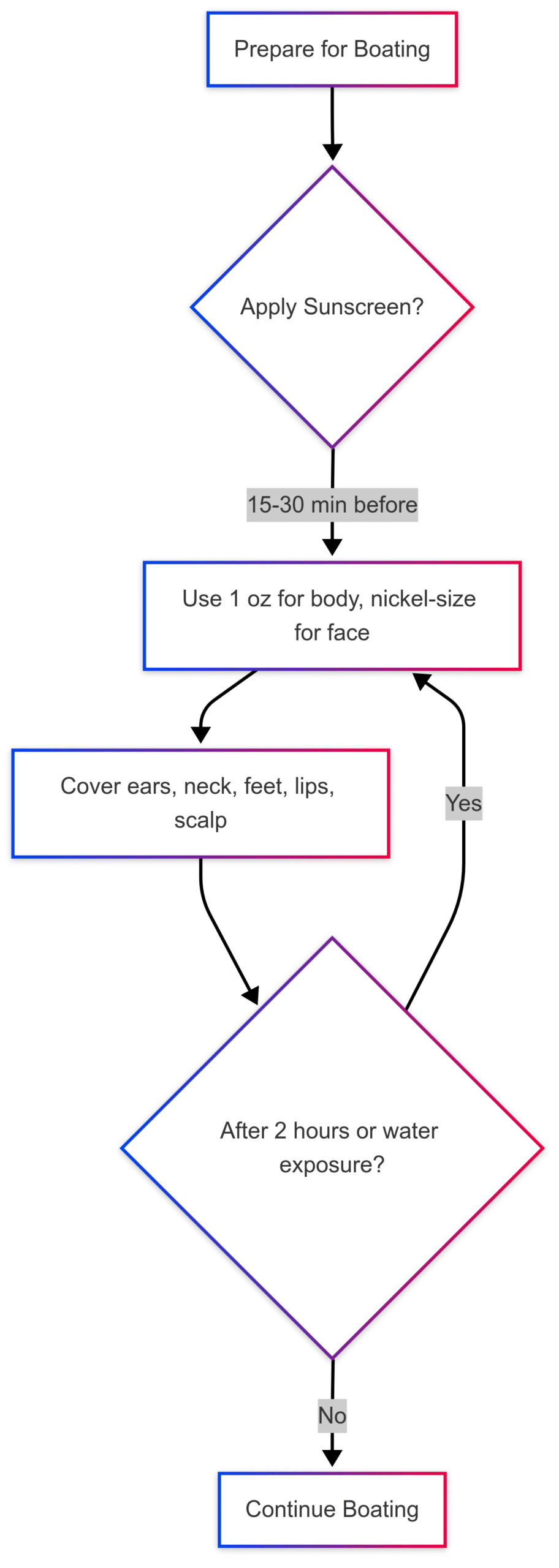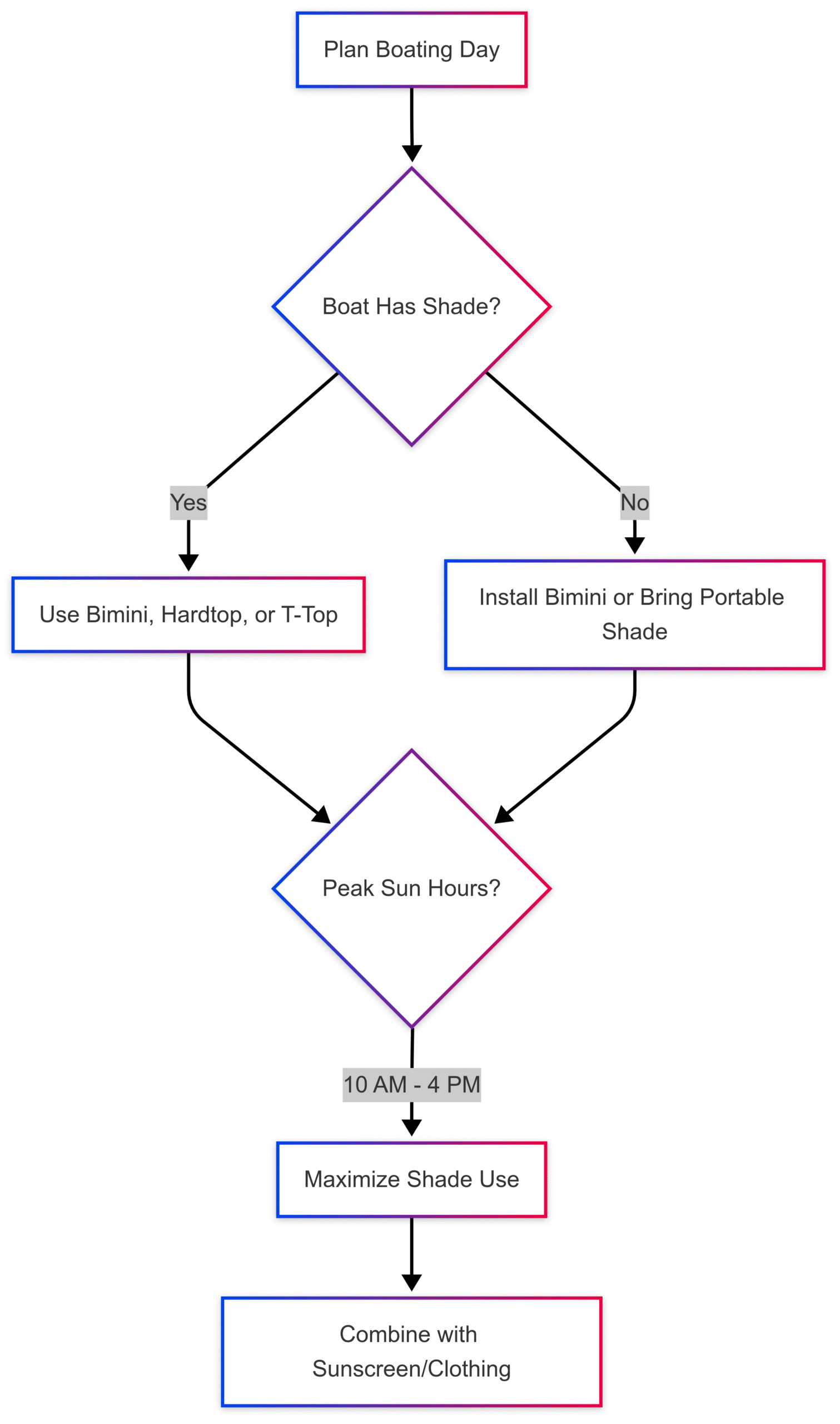Discover the top 5 sunscreen and sun safety tips for boaters to protect against UV rays, featuring expert advice, product recommendations, and practical strategies.
Boating offers an exhilarating escape, with sparkling waters and open skies creating the perfect backdrop for adventure. However, the same elements that make boating enjoyable—sun, water, and reflective surfaces—also amplify the risks of ultraviolet (UV) exposure. Boaters face intensified UV rays due to reflections off water, prolonged sun exposure, and limited shade, making sun safety a critical priority. According to the Skin Cancer Foundation, one in five Americans will develop skin cancer by age 70, and boaters are particularly vulnerable due to their environment. This comprehensive guide outlines the top five sunscreen and sun safety tips for boaters, combining expert recommendations, practical strategies, and product insights to ensure you enjoy the water safely.
Why Sun Safety is Critical for Boaters
Sun exposure on the water is uniquely hazardous. UV rays, which include UVA (responsible for aging and long-term skin damage) and UVB (linked to sunburn and skin cancer), penetrate the skin directly and reflect off water, doubling their intensity. The Centers for Disease Control and Prevention (CDC) notes that UV rays are strongest between 10 a.m. and 4 p.m., coinciding with peak boating hours, and can harm skin even on cloudy days. Prolonged exposure without protection increases the risk of sunburn, premature aging, sunspots, and skin cancer, including melanoma, the deadliest form.
Boaters also face practical challenges: water-resistant sunscreen can wear off, shade is often scarce, and sunscreen chemicals may damage boat upholstery. By adopting a multifaceted sun safety strategy—combining sunscreen, protective clothing, shade, and hydration—you can mitigate these risks and focus on enjoying your time on the water.
Tip 1: Choose the Right Sunscreen
Selecting an effective sunscreen is the foundation of sun safety. Not all sunscreens are equal, and boaters need products tailored to their unique environment.
Key Features to Look For
- Broad-Spectrum Protection: Choose a sunscreen labeled “broad-spectrum” to shield against both UVA and UVB rays. This ensures comprehensive protection against skin cancer, sunburn, and aging.
- SPF 30 or Higher: The American Academy of Dermatology (AAD) recommends SPF 30 or higher, which blocks approximately 97% of UVB rays. Higher SPFs (e.g., 50) offer marginal additional protection but are ideal for extended water exposure.
- Water-Resistant Formulas: Opt for water-resistant sunscreens that remain effective for 40 or 80 minutes during swimming or sweating. Reapplication is still necessary after water exposure or toweling off.
- Reef-Friendly Options: To protect marine ecosystems, select sunscreens free of oxybenzone and octinoxate, which contribute to coral bleaching. Look for mineral-based formulas with zinc oxide or titanium dioxide.
Physical vs. Chemical Sunscreens
| Type | Active Ingredients | Pros | Cons |
|---|---|---|---|
| Physical | Zinc oxide, titanium dioxide | Gentle on sensitive skin, immediate protection, eco-friendly | May leave a white residue, thicker texture |
| Chemical | Avobenzone, oxybenzone, octisalate, etc. | Absorbs easily, no visible residue, lightweight | Potential skin irritation, requires 15-30 minutes to absorb, less eco-friendly |
Recommendation: For boaters, physical sunscreens are often preferred due to their durability and environmental benefits. However, chemical sunscreens may be more convenient for those prioritizing ease of application.
Top Sunscreen Products for Boaters
| Product | Type | SPF | Water Resistance | Price (Approx.) | Key Features |
|---|---|---|---|---|---|
| Neutrogena Ultra Sheer Dry-Touch | Chemical | 55 | 80 minutes | $10-$12 | Lightweight, non-greasy, broad-spectrum |
| Blue Lizard Australian Sunscreen | Physical | 30 | 40 minutes | $15-$18 | Zinc oxide, reef-friendly, sensitive skin |
| EltaMD UV Sport Sunscreen | Physical | 50 | 80 minutes | $25-$30 | Non-comedogenic, sweat-resistant, UPF boost |
| Sun Bum Original Spray | Chemical | 50 | 80 minutes | $15-$17 | Easy spray application, reef-friendly option |
| ThinkSport Safe Sunscreen | Physical | 50 | 80 minutes | $12-$15 | Eco-friendly, zinc oxide, non-sticky |
Pro Tip: Test sunscreens on a small skin patch before boating to avoid irritation. Also, check product labels for boat-friendly formulas, as ingredients like avobenzone can stain upholstery.
Tip 2: Apply Sunscreen Properly
Even the best sunscreen is ineffective if applied incorrectly. Proper application maximizes protection and ensures coverage of vulnerable areas.
Application Guidelines
- Timing: Apply sunscreen 15-30 minutes before sun exposure to allow absorption. This is especially critical for chemical sunscreens, which need time to bond with the skin.
- Quantity: Use approximately one ounce (a shot glass full) for full-body coverage on an average adult. For the face, a nickel-sized amount suffices. Under-application reduces SPF effectiveness significantly.
- Reapplication: Reapply every two hours, or immediately after swimming, sweating, or toweling off. Set a timer to stay consistent, as water activities can make time pass quickly.
- Missed Areas: Pay attention to commonly neglected spots, including:
- Ears
- Back of the neck
- Tops of feet
- Lips (use SPF 30+ lip balm)
- Scalp (especially along the hairline or part)
Application Flowchart

Pro Tip: Use a sunscreen stick or spray for quick touch-ups on hard-to-reach areas like the back or scalp. Keep a travel-sized product in your boat bag for convenience.
Tip 3: Wear Sun-Protective Clothing and Accessories
Sunscreen alone isn’t enough for extended water exposure. Sun-protective clothing and accessories provide a physical barrier against UV rays, offering consistent protection without reapplication.
Sun-Protective Clothing
- UPF Rating: Choose clothing with an Ultraviolet Protection Factor (UPF) of 50+, which blocks 98% of UV rays. UPF 30-49 offers “very good” protection but is less comprehensive.
- Features: Look for lightweight, breathable, moisture-wicking fabrics with flatlock stitching to prevent chafing. Loose fits enhance comfort in hot conditions.
- Styles: Popular options include:
- Long-sleeve rash guards
- UPF-rated swimwear
- Neck gaiters or face shields
- Arm sleeves
Recommended Clothing Products
| Product | Type | UPF | Price (Approx.) | Key Features |
|---|---|---|---|---|
| Columbia PFG Long Sleeve Shirt | Rash Guard | 50 | $35-$45 | Omni-Shade, moisture-wicking, breathable |
| Coolibar UPF 50+ Swim Leggings | Swimwear | 50+ | $60-$80 | Chlorine-resistant, quick-dry, full coverage |
| Buff CoolNet UV Neck Gaiter | Neck Gaiter | 50 | $20-$25 | Cooling fabric, versatile, lightweight |
Accessories
- Wide-Brimmed Hats: Select hats with a 3-4 inch brim to shield the face, neck, and ears. UPF-rated hats are ideal for maximum protection.
- Polarized Sunglasses: Choose UV-blocking, polarized lenses to reduce water glare and protect against cataracts and other eye damage. Wraparound styles minimize side exposure.
Sunglasses Recommendations
| Product | Type | Price (Approx.) | Key Features |
|---|---|---|---|
| Costa Del Mar Rinconcito | Polarized | $180-$220 | 100% UV protection, durable, glare reduction |
| Maui Jim Peahi | Polarized | $250-$300 | Lightweight, scratch-resistant, UV-blocking |
| SunCloud Optics Loveseat | Polarized | $50-$70 | Budget-friendly, UV protection, stylish |
Pro Tip: Pair a neck gaiter with a wide-brimmed hat for near-total face and neck coverage, ideal for long days on the water.
Tip 4: Utilize Shade and Boat Features
Shade is a boater’s ally in reducing UV exposure. While open water offers little natural shade, boats often include built-in or aftermarket solutions.
Boat Shade Options
- Bimini Tops: Common on many boats, bimini tops provide overhead shade while allowing airflow. They’re affordable and easy to install if not standard.
- Hardtops/T-Tops: These offer permanent shade for the cockpit, ideal for larger vessels. Some include extendable awnings for additional coverage.
- Aftermarket Sunshades: Telescoping or electronic sunshades can attach to existing structures, extending shade forward or aft.
Shade Strategy Flowchart

Portable Shade Solutions
- Umbrellas: Clamp-on umbrellas are lightweight and effective for smaller boats or anchored stops.
- Pop-Up Canopies: These provide temporary shade for larger groups but require secure mounting to withstand wind.
Pro Tip: During peak UV hours (10 a.m. to 4 p.m.), combine shade with sunscreen and UPF clothing for layered protection. Take short breaks below deck or under shade to cool down.
Tip 5: Stay Hydrated and Educate Others
Hydration and awareness are often overlooked but essential components of sun safety. Dehydration exacerbates sun exposure’s effects, while education ensures everyone on board stays protected.
Hydration Tips
- Water Intake: Drink 8 ounces of water every 15-20 minutes in the sun to replace fluids lost through sweat. Bring at least one gallon per person for a full day on the water.
- Avoid Dehydrants: Limit alcohol and sugary drinks, which accelerate dehydration. Opt for electrolyte-rich drinks like coconut water or sports drinks for extended outings.
- Signs of Dehydration: Watch for dizziness, dry mouth, or fatigue. If symptoms appear, seek shade, rehydrate, and rest immediately.
Education Strategies
- Inform Passengers: Brief friends and family on sun safety before departing. Highlight the importance of sunscreen, reapplication, and shade.
- Teach Children: Use fun analogies (e.g., sunscreen as a “superhero shield”) to engage kids in sun protection habits. Ensure they wear UPF clothing and hats.
- Lead by Example: Model consistent sunscreen application and shade-seeking behavior to encourage others to follow suit.
Pro Tip: Assign a “sun safety captain” to remind the group to reapply sunscreen and hydrate, especially during long trips.
Additional Considerations
Check the UV Index
The UV Index, available through weather apps or NOAA, indicates daily UV intensity on a scale of 1-11+. Higher values (7+) require extra precautions, such as frequent reapplication and shade use. Check the index before boating to plan your protection strategy.
Beware of Reflections
Water reflects up to 20% of UV rays, amplifying exposure. Light-colored boat surfaces and nearby structures can also reflect rays, increasing risk to exposed skin.
Protect Your Boat
Sunscreen ingredients like avobenzone can stain vinyl upholstery or fiberglass. Use boat-friendly sunscreens or cover seats with towels during application. Clean spills immediately with a marine-safe cleaner.
Conclusion
Boating is a cherished pastime, but it demands proactive sun safety to protect against UV damage. By choosing broad-spectrum, water-resistant sunscreen with SPF 30+, applying it generously and frequently, wearing UPF-rated clothing, utilizing boat shade features, and staying hydrated, you can enjoy the water without compromising your health. Educating your crew and checking the UV Index further enhance safety, ensuring every outing is memorable for the right reasons.
Invest in quality products, plan your shade strategy, and prioritize reapplication to safeguard your skin and eyes. With these five sun safety tips, you’re equipped to navigate the waters confidently, preserving your health and maximizing your boating adventures.
Happy Boating!
Share The Top 5 Sunscreen and Sun Safety Tips for Boaters with your friends and leave a comment below with your thoughts.
Read 10 Best Boat Floats for a Day on the Water until we meet in the next article.
